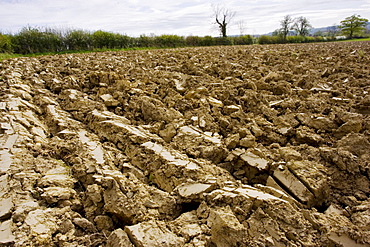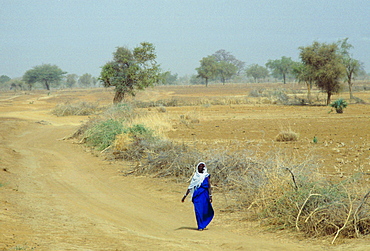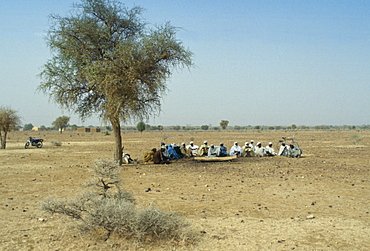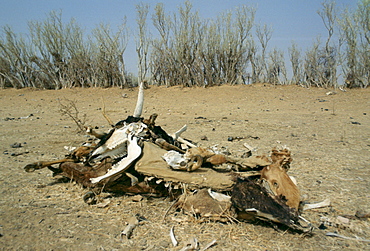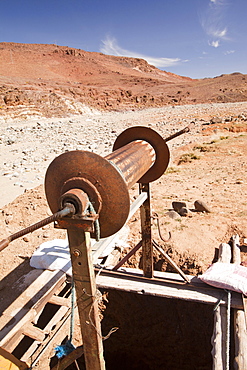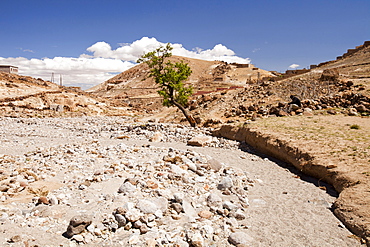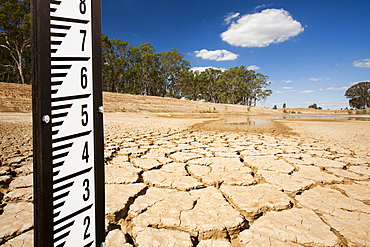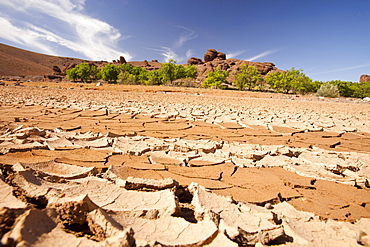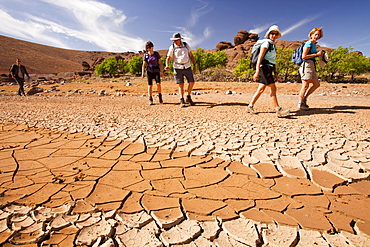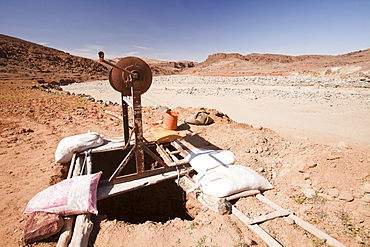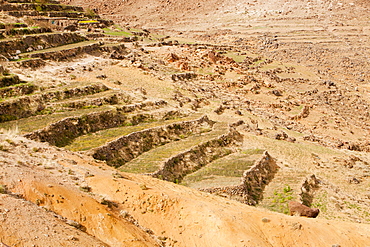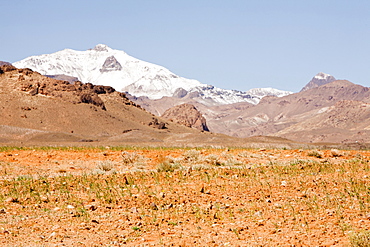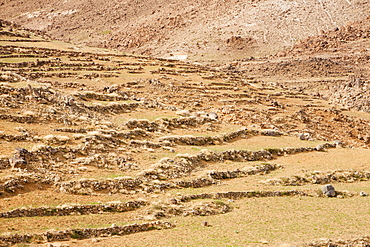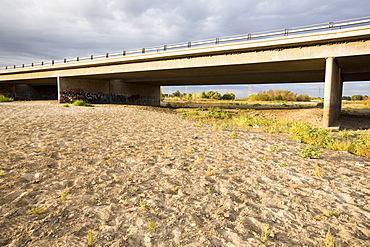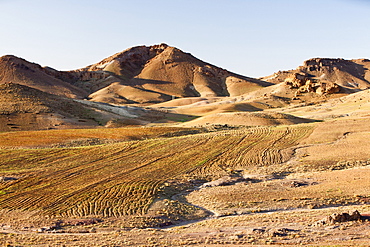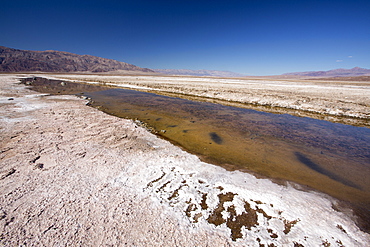Results
10 results found
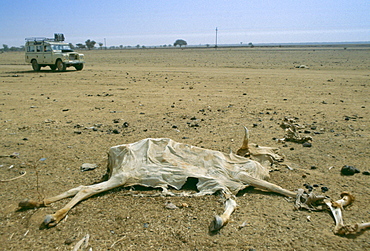
Drought in Burkina Faso (formerly Upper Volta). A white Land Rover 4-wheel drive vehicle drives past a dried out carcass.
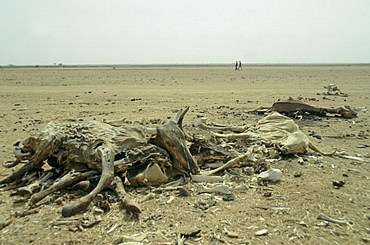
Drought scene - two men walking past the dried out carcasses of dead cattle in Burkina Faso (formerly Upper Volta)
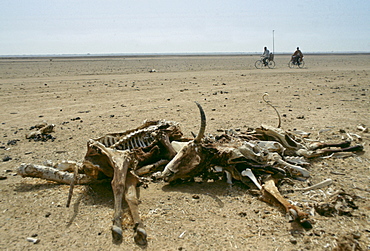
Locals on bicycles ride past carcasses of the bones of dead animals in the drought areas of Burkina Faso (formerly Upper Volta)
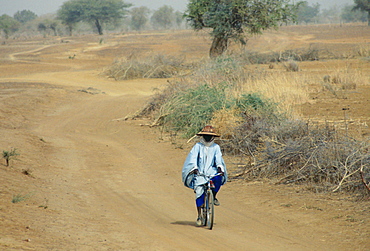
A local man wearing a sunhat rides a bicycle on the road to Sebba through the desert drought areas of Burkina Faso (formerly Upper Volta)
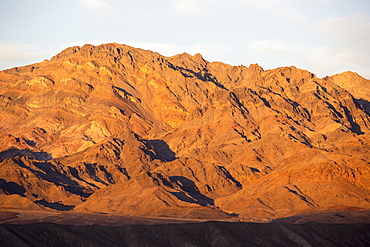
Badland scenery at Zabriskie Point at sunset in Death Valley which is the lowest, hottest, driest place in the USA, with an average annual rainfall of around 2 inches, some years it does not receive any rain at all.
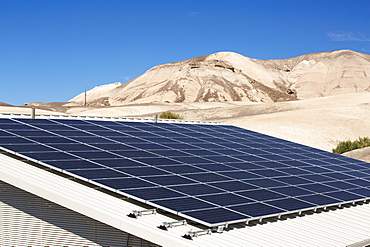
Solar panels amongst Badland scenery in Death Valley which is the lowest, hottest, driest place in the USA, with an average annual rainfall of around 2 inches, some years it does not receive any rain at all.
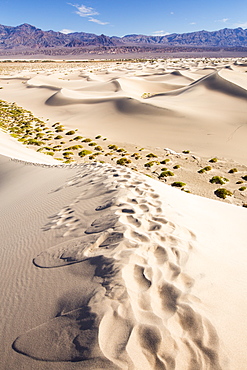
The Mesquite flat sand dunes in Death Valley which is the lowest, hottest, driest place in the USA, with an average annual rainfall of around 2 inches, some years it does not receive any rain at all.
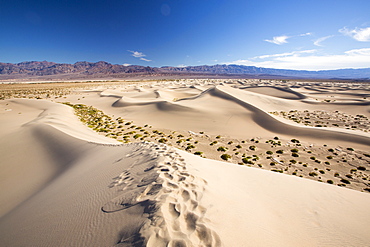
The Mesquite flat sand dunes in Death Valley which is the lowest, hottest, driest place in the USA, with an average annual rainfall of around 2 inches, some years it does not receive any rain at all.

The Mesquite flat sand dunes in Death Valley which is the lowest, hottest, driest place in the USA, with an average annual rainfall of around 2 inches, some years it does not receive any rain at all.

A dried up creek that when it contains water, supports Pup fish, a highly adapted fish that can tolerate high levels of salt. Death Valley is the lowest, hottest, driest place in the USA, with an average annual rainfall of around 2 inches, some years it does not receive any rain at all.
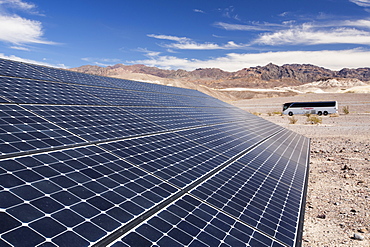
Solar panels at the Furnace Creek Visitor Centre in Death Valley. Death Valley is the lowest, hottest, driest place in the USA, with an average annual rainfall of around 2 inches, some years it does not receive any rain at all.
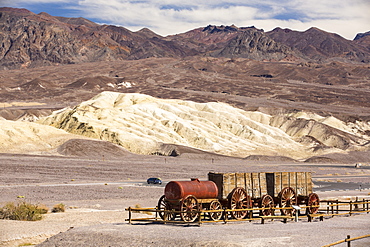
An old wagon train at the Harmony Borax works in Death Valley which is the lowest, hottest, driest place in the USA, with an average annual rainfall of around 2 inches, some years it does not receive any rain at all.
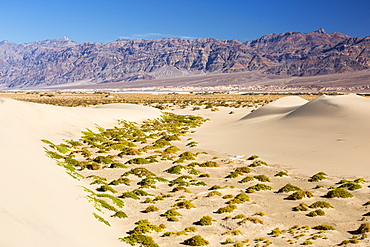
The Mesquite flat sand dunes in Death Valley which is the lowest, hottest, driest place in the USA, with an average annual rainfall of around 2 inches, some years it does not receive any rain at all.

Solar panels amongst Badland scenery in Death Valley which is the lowest, hottest, driest place in the USA, with an average annual rainfall of around 2 inches, some years it does not receive any rain at all.
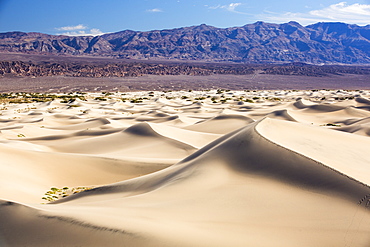
The Mesquite flat sand dunes in Death Valley which is the lowest, hottest, driest place in the USA, with an average annual rainfall of around 2 inches, some years it does not receive any rain at all.
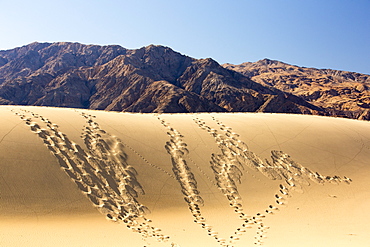
Footprints and lizard tracks on the Mesquite flat sand dunes in Death Valley which is the lowest, hottest, driest place in the USA, with an average annual rainfall of around 2 inches, some years it does not receive any rain at all.
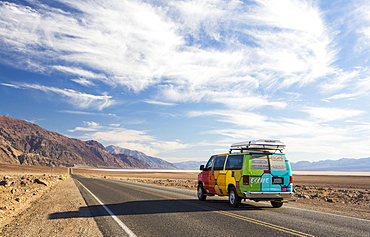
An RV on the road near Badwater which is the lowest point in the USA being 282 feet below sea level in Death Valley. Death Valley is the lowest, hottest, driest place in the USA, with an average annual rainfall of around 2 inches, some years it does not receive any rain at all.
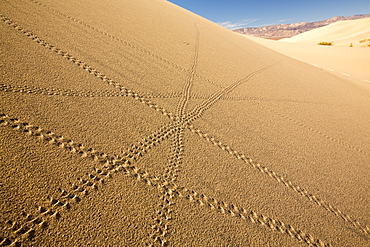
Lizard trails on the Mesquite flat sand dunes in Death Valley which is the lowest, hottest, driest place in the USA, with an average annual rainfall of around 2 inches, some years it does not receive any rain at all.
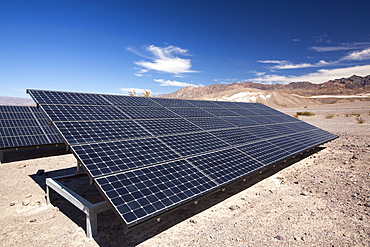
Solar panels at the Furnace Creek Visitor Centre in Death Valley. Death Valley is the lowest, hottest, driest place in the USA, with an average annual rainfall of around 2 inches, some years it does not receive any rain at all.
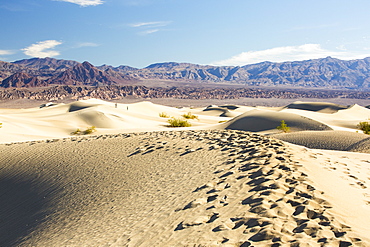
The Mesquite flat sand dunes in Death Valley which is the lowest, hottest, driest place in the USA, with an average annual rainfall of around 2 inches, some years it does not receive any rain at all.

Poor air quality caused by dust from the ongoing drought near Bakersfield, California, USA. Following an unprecedented four year long drought, Bakersfield is now the driest city in the USA. Most of California is in exceptional drought, the highest level of drought classification. 428,000 acres of agricultural land have been taken out of production due to lack of water, thousands of agricultural workers have lost their jobs and one third of all children in California go to bed hungry.
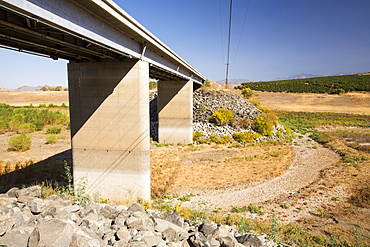
Lake Success near Porterville, Bakersfield is at 7% capacity. Ten years ago the water was so high you couldnt get a boat under the bridge. Bakersfield is now the driest city in the USA. Most of California is in exceptional drought, the highest level of drought classification. 428,000 acres of agricultural land have been taken out of production due to lack of water, thousands of agricultural workers have lost their jobs and one third of all children in California go to bed hungry.
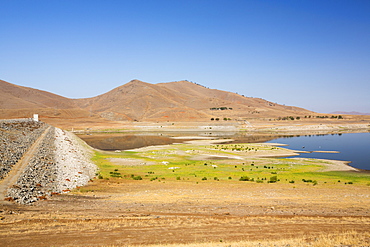
Lake Success near Porterville, Bakersfield is at 7% capacity. Bakersfield is now the driest city in the USA. Most of California is in exceptional drought, the highest level of drought classification. 428,000 acres of agricultural land have been taken out of production due to lack of water, thousands of agricultural workers have lost their jobs and one third of all children in California go to bed hungry.
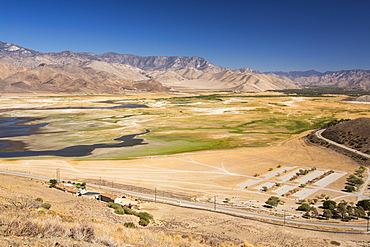
Lake Isabella near Bakersfield, East of California's Central valley is at less than 13% capacity following the four year long devastating drought. The reservoir has dropped so low, that the water level is below the outflow pipe.
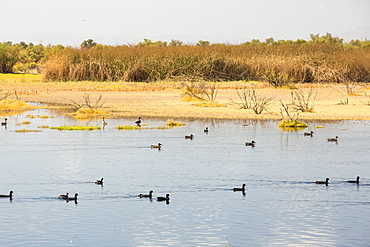
The Kern Valley Wildlife Refuge in California's Central Valley was created as important resting and feeding grounds for wildfowl migrating along the pacific flyway. After four years of unprecedented drought, the water shortages in California are critical. The reserve has received only 40% of its usual warer, with the result that most of the lake beds are dried up and dessicated, leaving the birds few places to go. This is the only area of lake with any water left.
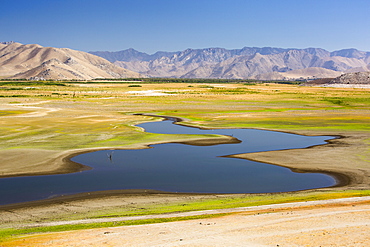
Lake Isabella near Bakersfield, East of California's Central valley is at less than 13% capacity following the four year long devastating drought. The reservoir has dropped so low, that the water level is below the outflow pipe.
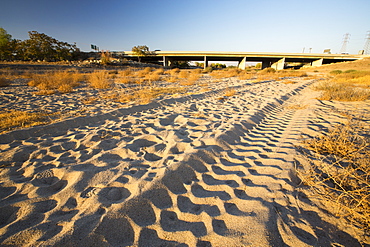
The dried up river bed of the Kern River in Bakersfield, California, USA. Following an unprecedented four year long drought, Bakersfield is now the driest city in the USA. Most of California is in exceptional drought, the highest level of drought classification. 428,000 acres of agricultural land have been taken out of production due to lack of water, thousands of agricultural workers have lost their jobs and one third of all children in California go to bed hungry.

Lake Isabella near Bakersfield, East of California's Central valley is at less than 13% capacity following the four year long devastating drought. The reservoir has dropped so low, that the water level is below the outflow pipe.

The Kern Valley Wildlife Refuge in California's Central Valley was created as important resting and feeding grounds for wildfowl migrating along the pacific flyway. After four years of unprecedented drought, the water shortages in California are critical. The reserve has received only 40% of its usual warer, with the result that most of the lake beds are dried up and dessicated, leaving the birds nowhere to go.

Grubbed out Olive trees that no longer have water to irrigate them near Bakersfield, California, USA. Following an unprecedented four year long drought, Bakersfield is now the driest city in the USA. Most of California is in exceptional drought, the highest level of drought classification. 428,000 acres of agricultural land have been taken out of production due to lack of water, thousands of agricultural workers have lost their jobs and one third of all children in California go to bed hungry.

Dead and dying Almond trees in Almond groves in Wasco in the Central Valley of California after the irrigation water ran out following the four year long drought in the Western USA. 80% of the world's almonds are grown in California, and it takes 1.1 gallons of water to grow each nut. Many farms have run out of water, and $2.2 Billion has been wiped off the agricultue sector annually. Currently one third of all children in California go to be hungry, as a direct result of job losses connected to the drought. 428,000 acres of farmland have been taken out of production as a result of the drought, in the Central Valley.
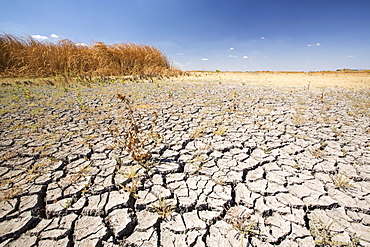
The Kern Valley Wildlife Refuge in California's Central Valley was created as important resting and feeding grounds for wildfowl migrating along the pacific flyway. After four years of unprecedented drought, the water shortages in California are critical. The reserve has received only 40% of its usual warer, with the result that most of the lake beds are dried up and dessicated, leaving the birds nowhere to go.
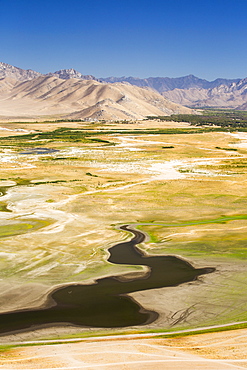
Lake Isabella near Bakersfield, East of California's Central valley is at less than 13% capacity following the four year long devastating drought. The reservoir has dropped so low, that the water level is below the outflow pipe.
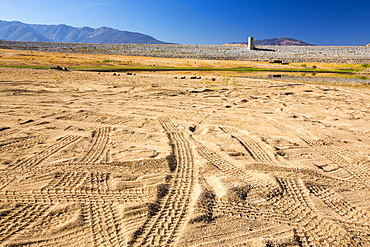
Lake Isabella near Bakersfield, East of California's Central valley is at less than 13% capacity following the four year long devastating drought. The reservoir has dropped so low, that the water level is below the outflow pipe.
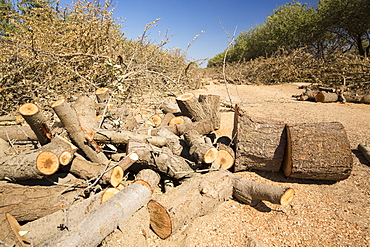
Almond groves being chopped down as there is no longer water available to irrigate them, in Wasco in the Central Valley of California following the four year long drought in the Western USA. 80% of the world's almonds are grown in California, and it takes 1.1 gallons of water to grow each nut. Many farms have run out of water, and $2.2 Billion has been wiped off the agricultue sector annually. Currently one third of all children in California go to be hungry, as a direct result of job losses connected to the drought. 428,000 acres of farmland have been taken out of production as a result of the drought, in the Central Valley.

Dying Olive trees that no longer have water to irrigate them near Bakersfield, California, USA. Following an unprecedented four year long drought, Bakersfield is now the driest city in the USA. Most of California is in exceptional drought, the highest level of drought classification. 428,000 acres of agricultural land have been taken out of production due to lack of water, thousands of agricultural workers have lost their jobs and one third of all children in California go to bed hungry.
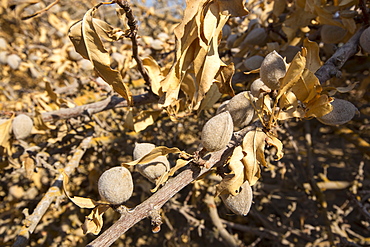
Almond groves being chopped down as there is no longer water available to irrigate them, in Wasco in the Central Valley of California following the four year long drought in the Western USA. 80% of the world's almonds are grown in California, and it takes 1.1 gallons of water to grow each nut. Many farms have run out of water, and $2.2 Billion has been wiped off the agricultue sector annually. Currently one third of all children in California go to be hungry, as a direct result of job losses connected to the drought. 428,000 acres of farmland have been taken out of production as a result of the drought, in the Central Valley.
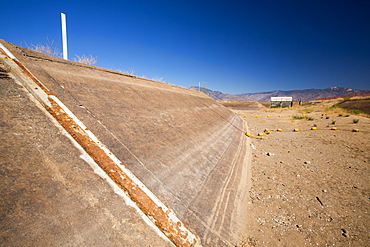
Lake Isabella near Bakersfield, East of California's Central valley is at less than 13% capacity following the four year long devastating drought. The reservoir has dropped so low, that the water level is below the outflow pipe, shown here.
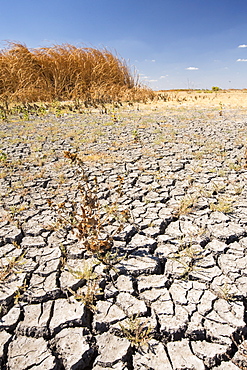
The Kern Valley Wildlife Refuge in California's Central Valley was created as important resting and feeding grounds for wildfowl migrating along the pacific flyway. After four years of unprecedented drought, the water shortages in California are critical. The reserve has received only 40% of its usual warer, with the result that most of the lake beds are dried up and dessicated, leaving the birds nowhere to go.
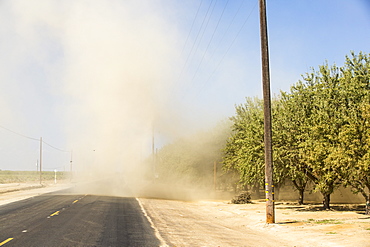
Almond groves in Wasco in the Central Valley of California that are vulnerable following the four year long drought in the Western USA. 80% of the world's almonds are grown in California, and it takes 1.1 gallons of water to grow each nut. Many farms have run out of water, and $2.2 Billion has been wiped off the agricultue sector annually. Currently one third of all children in California go to be hungry, as a direct result of job losses connected to the drought. 428,000 acres of farmland have been taken out of production as a result of the drought, in the Central Valley.

Lake Isabella near Bakersfield, East of California's Central valley is at less than 13% capacity following the four year long devastating drought. The reservoir has dropped so low, that the water level is below the outflow pipe. This shot shows the boat launching jetty, that has been taken as far down the ramp as possible, and is still nowhere near the water level.
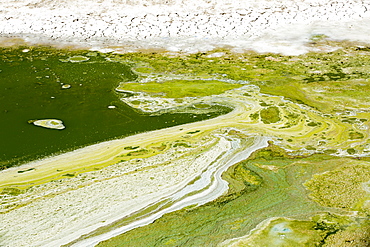
A dried up lake at Tehachapi Pass, California, USA. California is in the midst of a four year long drought.
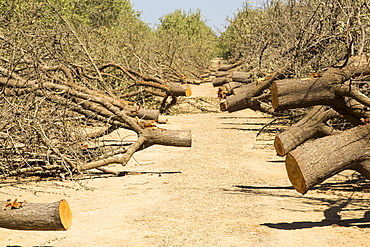
Almond groves being chopped down as there is no longer water available to irrigate them, in Wasco in the Central Valley of California following the four year long drought in the Western USA. 80% of the world's almonds are grown in California, and it takes 1.1 gallons of water to grow each nut. Many farms have run out of water, and $2.2 Billion has been wiped off the agricultue sector annually. Currently one third of all children in California go to be hungry, as a direct result of job losses connected to the drought. 428,000 acres of farmland have been taken out of production as a result of the drought, in the Central Valley.

Abandoned dead and dying Orange trees that no longer have water to irrigate them near Bakersfield, California, USA. Following an unprecedented four year long drought, Bakersfield is now the driest city in the USA. Most of California is in exceptional drought, the highest level of drought classification. 428,000 acres of agricultural land have been taken out of production due to lack of water, thousands of agricultural workers have lost their jobs and one third of all children in California go to bed hungry.

An RV that until recently would be 40 feet underwater on the lake bed of Lake Isabella near Bakersfield, East of California's Central valley which is at less than 13% capacity following the four year long devastating drought. The reservoir has dropped so low, that the water level is below the outflow pipe.
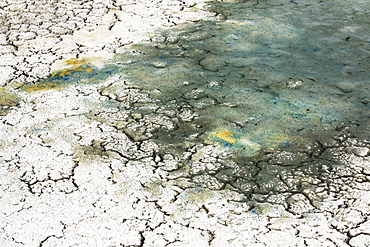
A dried up lake at Tehachapi Pass, California, USA. California is in the midst of a four year long drought.
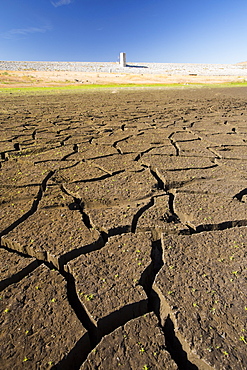
Lake Isabella near Bakersfield, East of California's Central valley is at less than 13% capacity following the four year long devastating drought. The reservoir has dropped so low, that the water level is below the outflow pipe.
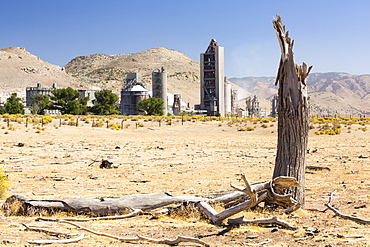
A cement works at Tehachapi Pass California, USA, with drought killed trees in the foreground. Cement production is one of the most carbon hungry industries on the planet, driving climate change and leading to drought.

Abandoned dead and dying Orange trees that no longer have water to irrigate them near Bakersfield, California, USA. Following an unprecedented four year long drought, Bakersfield is now the driest city in the USA. Most of California is in exceptional drought, the highest level of drought classification. 428,000 acres of agricultural land have been taken out of production due to lack of water, thousands of agricultural workers have lost their jobs and one third of all children in California go to bed hungry.

Burnt ground from a wildfire near Bakersfield, California, USA. Following an unprecedented four year long drought, Bakersfield is now the driest city in the USA. Most of California is in exceptional drought, the highest level of drought classification. Wild fires are much more common due to the drought. 428,000 acres of agricultural land have been taken out of production due to lack of water, thousands of agricultural workers have lost their jobs and one third of all children in California go to bed hungry.
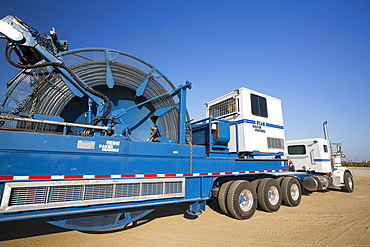
A fracking truck next to a site being fracked near Wasco in California's Central Valley, USA. Fracking for natural gas and oil, has reduced energy prices in the US, but fracking is a water hungry industry, that competes directly with the agricultural sector for water. After a 4 year long drought water is running out. Fracking also contaminates ground water supplies from all the chemicals that are pumped underground to frack the fossil fuel bearing rocks.
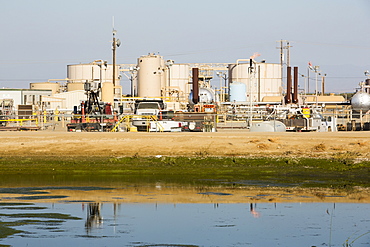
A fracking site being fracked near Wasco in California's Central Valley, USA. Fracking for natural gas and oil, has reduced energy prices in the US, but fracking is a water hungry industry, that competes directly with the agricultural sector for water. After a 4 year long drought water is running out. Fracking also contaminates ground water supplies from all the chemicals that are pumped underground to frack the fossil fuel bearing rocks.
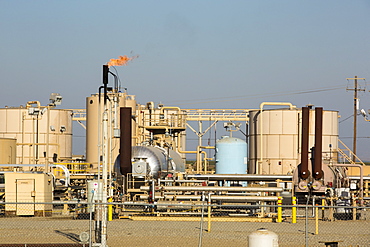
A fracking site being fracked near Wasco in California's Central Valley, USA. Fracking for natural gas and oil, has reduced energy prices in the US, but fracking is a water hungry industry, that competes directly with the agricultural sector for water. After a 4 year long drought water is running out. Fracking also contaminates ground water supplies from all the chemicals that are pumped underground to frack the fossil fuel bearing rocks.
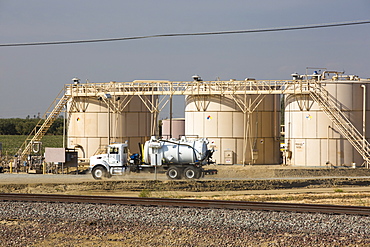
A fracking site being fracked near Wasco in California's Central Valley, USA. Fracking for natural gas and oil, has reduced energy prices in the US, but fracking is a water hungry industry, that competes directly with the agricultural sector for water. After a 4 year long drought water is running out. Fracking also contaminates ground water supplies from all the chemicals that are pumped underground to frack the fossil fuel bearing rocks.
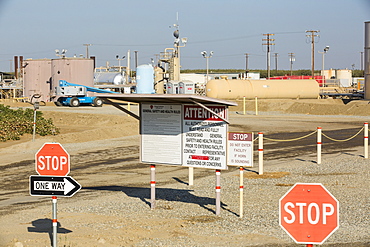
A fracking truck on a site being fracked near Wasco in California's Central Valley, USA. Fracking for natural gas and oil, has reduced energy prices in the US, but fracking is a water hungry industry, that competes directly with the agricultural sector for water. After a 4 year long drought water is running out. Fracking also contaminates ground water supplies from all the chemicals that are pumped underground to frack the fossil fuel bearing rocks.
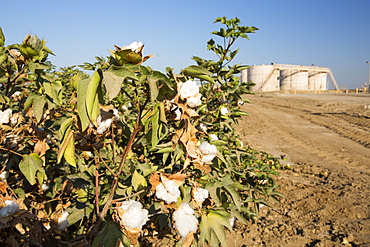
A fracking site being fracked near Wasco in California's Central Valley, USA, next to a farmers Cotton crop. Fracking for natural gas and oil, has reduced energy prices in the US, but fracking is a water hungry industry, that competes directly with the agricultural sector for water. After a 4 year long drought water is running out. Fracking also contaminates ground water supplies from all the chemicals that are pumped underground to frack the fossil fuel bearing rocks.
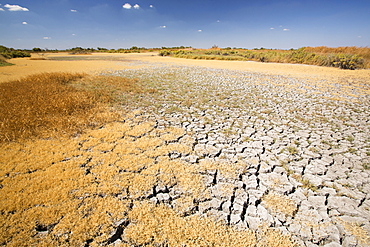
The Kern Valley Wildlife Refuge in California's Central Valley was created as important resting and feeding grounds for wildfowl migrating along the pacific flyway. After four years of unprecedented drought, the water shortages in California are critical. The reserve has received only 40% of its usual warer, with the result that most of the lake beds are dried up and dessicated, leaving the birds nowhere to go.
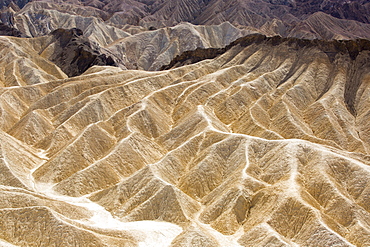
Badland scenery at Zabriskie Point in Death Valley which is the lowest, hottest, driest place in the USA, with an average annual rainfall of around 2 inches, some years it does not receive any rain at all.
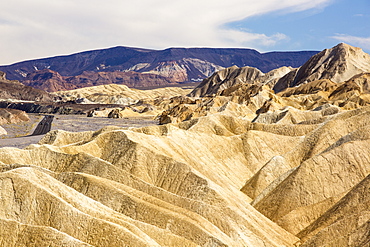
Badland scenery at Zabriskie Point in Death Valley which is the lowest, hottest, driest place in the USA, with an average annual rainfall of around 2 inches, some years it does not receive any rain at all.
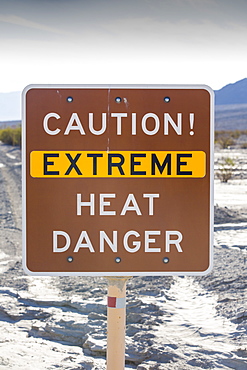
An extreme heat danger sign in Death Valley which is the lowest, hottest, driest place in the USA, with an average annual rainfall of around 2 inches, some years it does not receive any rain at all.
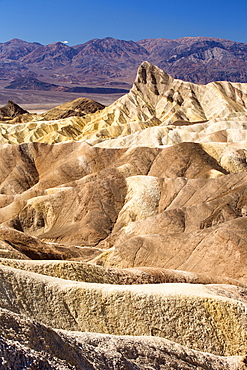
Badland scenery at Zabriskie Point in Death Valley which is the lowest, hottest, driest place in the USA, with an average annual rainfall of around 2 inches, some years it does not receive any rain at all.
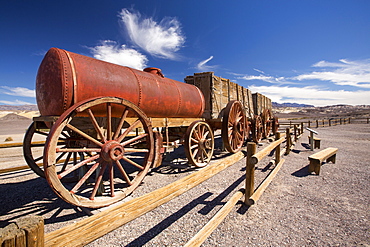
An old wagon train at the Harmony Borax works in Death Valley which is the lowest, hottest, driest place in the USA, with an average annual rainfall of around 2 inches, some years it does not receive any rain at all.
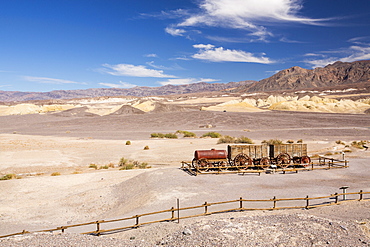
An old wagon train at the Harmony Borax works in Death Valley which is the lowest, hottest, driest place in the USA, with an average annual rainfall of around 2 inches, some years it does not receive any rain at all.
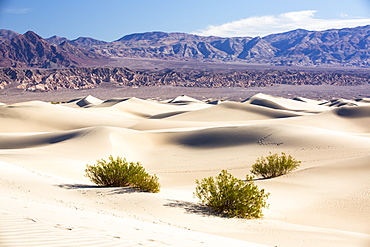
The Mesquite flat sand dunes in Death Valley which is the lowest, hottest, driest place in the USA, with an average annual rainfall of around 2 inches, some years it does not receive any rain at all.
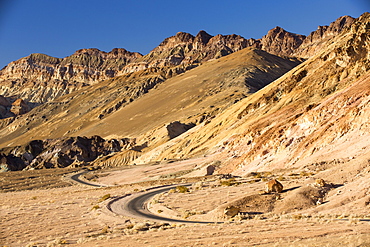
Colourful rocks from Artists Drive in Death Valley which is the lowest, hottest, driest place in the USA, with an average annual rainfall of around 2 inches, some years it does not receive any rain at all.
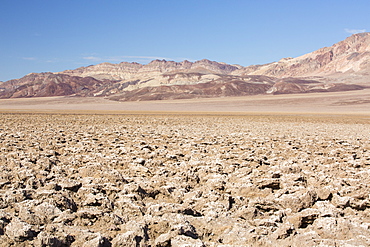
The Devils Golf Course in Death Valley which is the lowest, hottest, driest place in the USA, with an average annual rainfall of around 2 inches, some years it does not receive any rain at all.
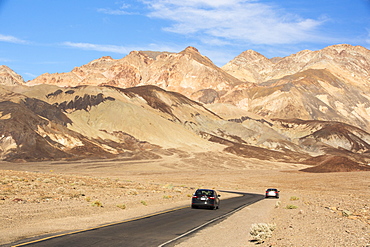
Colourful rocks from Artists Drive in Death Valley which is the lowest, hottest, driest place in the USA, with an average annual rainfall of around 2 inches, some years it does not receive any rain at all.

Colourful rocks from Artists Drive in Death Valley which is the lowest, hottest, driest place in the USA, with an average annual rainfall of around 2 inches, some years it does not receive any rain at all.
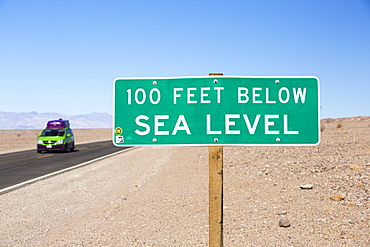
A sign at 100 feet below sea level in Death Valley which is the lowest, hottest, driest place in the USA, with an average annual rainfall of around 2 inches, some years it does not receive any rain at all.
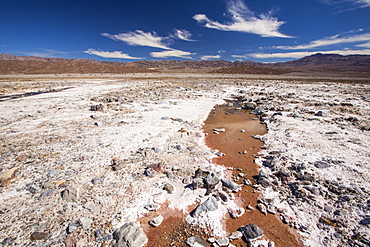
Saline creeks in Death Valley which is the lowest, hottest, driest place in the USA, with an average annual rainfall of around 2 inches, some years it does not receive any rain at all.

High grazing land above a Berber village in the Anti Atlas mountains of Morocco, North Africa, Africa
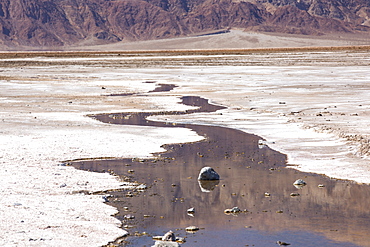
Saline creeks in Death Valley which is the lowest, hottest, driest place in the USA, with an average annual rainfall of around 2 inches, some years it does not receive any rain at all.
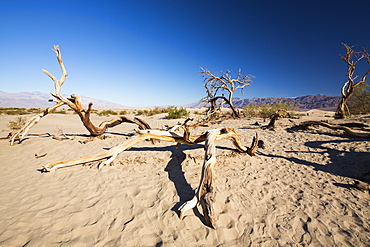
Death Valley is the lowest, hottest, driest place in the USA, with an average annual rainfall of around 2 inches, some years it does not receive any rain at all.

The contrast between agricultural land being irrigated, and the parched dessicated land not irrigated, after four years of California's catastrophic drought. $2 billion has been wiped off California's agricultural sector.
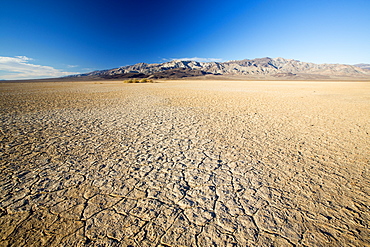
Death Valley is the lowest, hottest, driest place in the USA, with an average annual rainfall of around 2 inches, some years it does not receive any rain at all.
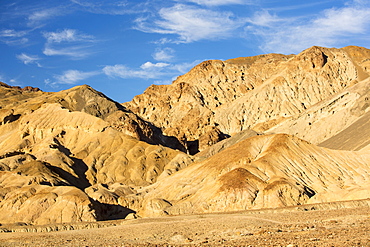
Colourful rocks from Artists Drive in Death Valley which is the lowest, hottest, driest place in the USA, with an average annual rainfall of around 2 inches, some years it does not receive any rain at all.
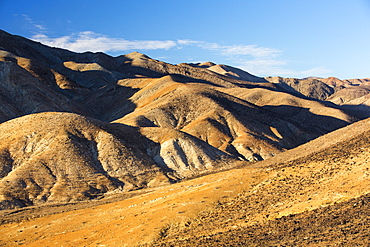
Badland scenery in Death Valley which is the lowest, hottest, driest place in the USA, with an average annual rainfall of around 2 inches, some years it does not receive any rain at all.
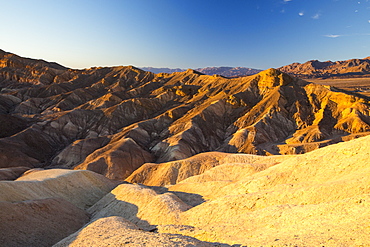
Badland scenery at sunset, Zabriskie Point in Death Valley which is the lowest, hottest, driest place in the USA, with an average annual rainfall of around 2 inches, some years it does not receive any rain at all.
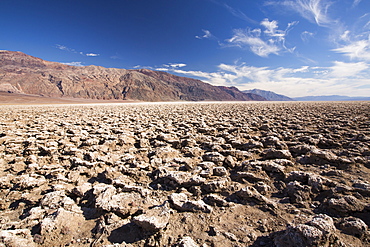
The Devils Golf course in Death Valley which is the lowest, hottest, driest place in the USA, with an average annual rainfall of around 2 inches, some years it does not receive any rain at all.
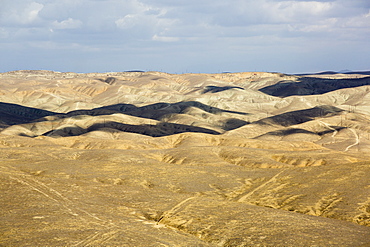
Drought parched ranchland in Bakersfield, California, USA. Following an unprecedented four year long drought, Bakersfield is now the driest city in the USA.
